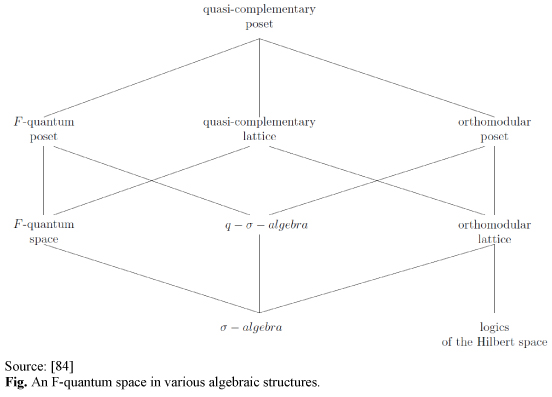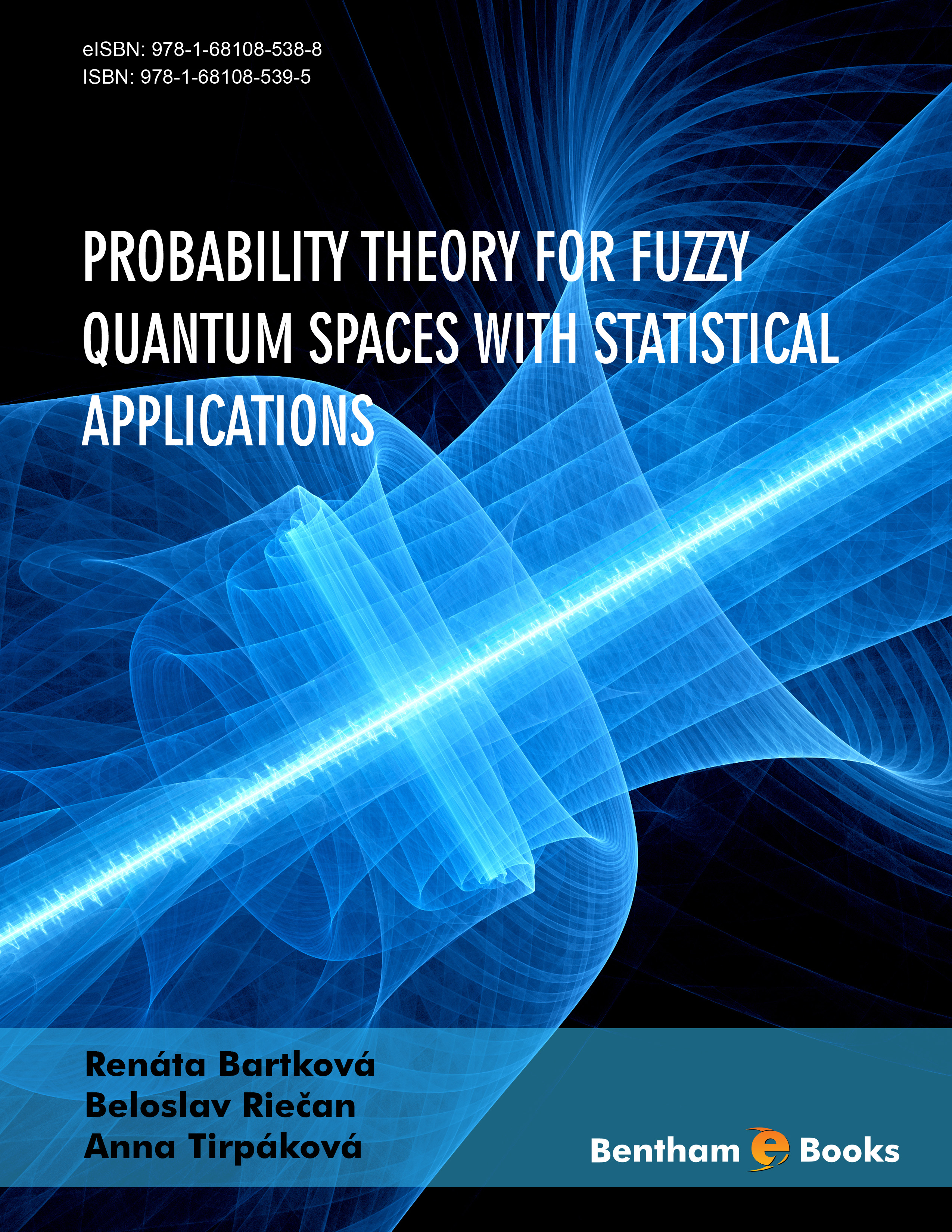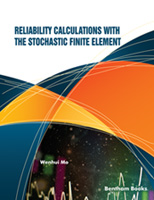Probability theory, like other mathematical disciplines, underwent a tumultuous development in the past. In 1933 Kolmogorov published work [39], in which he introduced the axiomatic model of his probability theory. In classical probability theory based on Kolmogorov axiomatic model it is assumed that the events associated with the experiment form the Boolean σ-algebra of subsets 𝒮 of the set Ω. Probability is then the σ-additive nonnegative final function P on 𝒮 with values in interval [0,1], whereby it holds that if {An} is a sequence of mutually exclusive events from S, then 
At present, we can say that Kolmogorov axioms deeply infiltrated not only into probability theory and mathematical statistics, but they also encouraged the development of other scientific disciplines, such as physics, biology, economics, social sciences, etc.
Over time, however, it has emerget that for some scientific disciplines, for example quantum mechanics, the concept of σ-algebra is too limiting. It does not describe such situations that arise in connection with Heisenberg uncertainty principle, which claims that if any two observables (such as a position x and a momentum y) are measured at the same time, the product of the squares of errors of measurement  and
and  is connected with the inequality
is connected with the inequality  , i.e. the accuracy of measurement of one variable happens at the expense of the second one. Birkhoff and von Neumann [5] pointed to the fact that the set of experimentally verifiable statements about quantum-mechanical system has different algebraic structure than the Boolean algebra in [39]. The first attempts at the mathematical formulation of the quantum mechanics come from Heisenberg [35] and Schrödinger [96]. Heisenberg proposed the formalism of matrix mechanics and Schrödinger the one of wave mechanics. Both theories were generalized by von Neumann [63]. He proposed a model of quantum mechanics based on a complex separable Hilbert space.
, i.e. the accuracy of measurement of one variable happens at the expense of the second one. Birkhoff and von Neumann [5] pointed to the fact that the set of experimentally verifiable statements about quantum-mechanical system has different algebraic structure than the Boolean algebra in [39]. The first attempts at the mathematical formulation of the quantum mechanics come from Heisenberg [35] and Schrödinger [96]. Heisenberg proposed the formalism of matrix mechanics and Schrödinger the one of wave mechanics. Both theories were generalized by von Neumann [63]. He proposed a model of quantum mechanics based on a complex separable Hilbert space.
Nowadays, one of the most used axiomatic models of quantum mechanics is quantum logic, which recorded a rapid development in 1960, when works of Varadarajan [103], Mackey [43], Mac Laren [42], Gunson [29] and others appeared.
The basic mathematical model of the current quantum theory is the von Neumann model, based on the geometry of Hilbert space (Varadarajan, [103]). If we define the system M of all closed subspaces of the given Hilbert space (where the notion "a state of system" means a measure of probability on  according to Varadarajan [103]), and this definition of the state is compared with the definition of P-measure on fuzzy sets (according to Piasecki [70]), we can see that both objects have similar algebraic structure. In 1985 Piasecki [70] submitted a model called soft σ-algebra in the fuzzy set theory. This model demonstrated several identical characteristics of this new structure with quantum logics. That analogy, which was for the first time observed by Riečan [79] and later by Pykacz [73], led us to the idea to build a quantum theory based on fuzzy sets.
according to Varadarajan [103]), and this definition of the state is compared with the definition of P-measure on fuzzy sets (according to Piasecki [70]), we can see that both objects have similar algebraic structure. In 1985 Piasecki [70] submitted a model called soft σ-algebra in the fuzzy set theory. This model demonstrated several identical characteristics of this new structure with quantum logics. That analogy, which was for the first time observed by Riečan [79] and later by Pykacz [73], led us to the idea to build a quantum theory based on fuzzy sets.
The theory of fuzzy sets originated in 1960s in connection with the emergence of article by Zadeh [106]. If we return to the analogy between quantum logics and fuzzy sets theory, according to Dvurečenskij [13] a fuzzy set can be viewed as a fuzzy event, respectively as a real-valued function, which is defined on set  with values in the interval [0,1], which describes the fuzziness of set (event) a within the meaning of Zadeh [106]. Number a(x) indicate the measure of membership of point x to set a. If X is a non-empty set, called the universum, and
with values in the interval [0,1], which describes the fuzziness of set (event) a within the meaning of Zadeh [106]. Number a(x) indicate the measure of membership of point x to set a. If X is a non-empty set, called the universum, and  is a system of fuzzy subsets of universum X, i.e. the system of functions on X with values in interval [0, 1], then according to Riečan [79] we say that (X,
is a system of fuzzy subsets of universum X, i.e. the system of functions on X with values in interval [0, 1], then according to Riečan [79] we say that (X, ) is an F- quantum space, according to Dvurečenskij and Chovanec [17] also called a fuzzy quantum space, or according to Dvurečenskij [12] a fuzzy measurable space. The set
) is an F- quantum space, according to Dvurečenskij and Chovanec [17] also called a fuzzy quantum space, or according to Dvurečenskij [12] a fuzzy measurable space. The set  according to Piasecki [70] is also called a soft σ-algebra.
according to Piasecki [70] is also called a soft σ-algebra.
More general structures of fuzzy quantum spaces were studied by Dvurečenskij and Chovanec [16, 17] and Dvurečenskij, Chovanec and Kôpka [18]. The law of exclusions of the third or orthomodular law does not apply on set  , which according to Mittelstaedt [57] can play certain role in axiomatic models of quantum mechanics.
, which according to Mittelstaedt [57] can play certain role in axiomatic models of quantum mechanics.
In the theory of fuzzy quantum spaces many authors try to prove some known assertions from the classical probability theory. For example, the existence of fuzzy state on fuzzy quantum space was studied by Dvurečenskij [12], Navara [59] and Navara, Pták [60, 61], joint fuzzy observables and joint distributions of fuzzy observables were studied by Dvurečenskij and Riečan [21, 22]. Dvurečenskij, Kôpka and Riečan [19] proved the representation theorem, which also includes thecase in fuzzy quantum space. The theory of an indefinite integral on the fuzzy quantum space was studied by Riečan [82, 83] and the extension of the validity of the Bayes formula for fuzzy sets was investigated by Mesiar [53-55], Piasecki [68, 69] Piasecki and Svitalski [71]. The entropy on fuzzy quantum space was studied by Markechová [46, 48, 49].
An important fact for the study of many assertions in the fuzzy sets theory is the existence of sum of fuzzy observables. Harman and Riečan [34] proved the existence of the sum of compatible fuzzy observables.
Among the important concepts of probability theory belong various types of convergence of random variables, which are important especially for those parts which deal with the validity of various forms of the law of large numbers and the central limit theorem. Thus the problem of generalizations of different types of convergence for fuzzy quantum space (X, ) became topical. Several authors studied particular types of convergences on quantum logic. We will mention only those works which were the basic material for the study of various types of convergences of fuzzy observables on fuzzy quantum space (X,
) became topical. Several authors studied particular types of convergences on quantum logic. We will mention only those works which were the basic material for the study of various types of convergences of fuzzy observables on fuzzy quantum space (X, ), and that is Dvurečenskij and Pulmanová [20], Jajte [37], Ochs [64, 65], Cushen [9], Gudder [26], Révesz [76]. Dvurečenskij [10], Riečan [80, 81], Chovanec and Kôpka [36], Kôpka and Chovanec [40], and others dealt with some types of convergences of fuzzy observables on fuzzy quantum space.
), and that is Dvurečenskij and Pulmanová [20], Jajte [37], Ochs [64, 65], Cushen [9], Gudder [26], Révesz [76]. Dvurečenskij [10], Riečan [80, 81], Chovanec and Kôpka [36], Kôpka and Chovanec [40], and others dealt with some types of convergences of fuzzy observables on fuzzy quantum space.
The issue of the ergodic theory on quantum logics was studied by more authors. Here we present only those works which were the basis for the generalization of the ergodic theory for fuzzy quantum space (X, ): Pulmanová [72], Dvurečenskij [15] and Mesiar [56]. The first authors to prove the individual ergodic theorem for compatible fuzzy observables on fuzzy quantum space were Harman and Riečan [34]. The proof of the individual ergodic theorem for more general case is provided in this book.
): Pulmanová [72], Dvurečenskij [15] and Mesiar [56]. The first authors to prove the individual ergodic theorem for compatible fuzzy observables on fuzzy quantum space were Harman and Riečan [34]. The proof of the individual ergodic theorem for more general case is provided in this book.
The Hahn-Jordann decomposition on quantum logics exists only in partial cases, for example it exists on the logic of Hilbert space (Šerstnev [99], Dvurečenskij [14], Rüttimann [94]). The Hahn-Jordann decomposition on fuzzy quantum space is studied in this book (Chapter 4).
The following figure displays the position of fuzzy quantum space in various algebraic structures.

CONFLICT OF INTEREST
The authors confirm that this eBook content has no conflict of interest.
ACKNOWLEDGMENT
Hereby we would like to thank prof. Ferdinand Chovanec for his Foreword, and Tomáš Škraban, PhD. and Zuzana Naštická, M.A. for reviewing the English language correctuess. We also acknowledge the Bentham Science Publishers and referees for their remarks and recommendations.



 and
and  is connected with the inequality
is connected with the inequality  , i.e. the accuracy of measurement of one variable happens at the expense of the second one. Birkhoff and von Neumann [5] pointed to the fact that the set of experimentally verifiable statements about quantum-mechanical system has different algebraic structure than the Boolean algebra in [39]. The first attempts at the mathematical formulation of the quantum mechanics come from Heisenberg [35] and Schrödinger [96]. Heisenberg proposed the formalism of matrix mechanics and Schrödinger the one of wave mechanics. Both theories were generalized by von Neumann [63]. He proposed a model of quantum mechanics based on a complex separable Hilbert space.
, i.e. the accuracy of measurement of one variable happens at the expense of the second one. Birkhoff and von Neumann [5] pointed to the fact that the set of experimentally verifiable statements about quantum-mechanical system has different algebraic structure than the Boolean algebra in [39]. The first attempts at the mathematical formulation of the quantum mechanics come from Heisenberg [35] and Schrödinger [96]. Heisenberg proposed the formalism of matrix mechanics and Schrödinger the one of wave mechanics. Both theories were generalized by von Neumann [63]. He proposed a model of quantum mechanics based on a complex separable Hilbert space. according to Varadarajan [103]), and this definition of the state is compared with the definition of P-measure on fuzzy sets (according to Piasecki [70]), we can see that both objects have similar algebraic structure. In 1985 Piasecki [70] submitted a model called soft σ-algebra in the fuzzy set theory. This model demonstrated several identical characteristics of this new structure with quantum logics. That analogy, which was for the first time observed by Riečan [79] and later by Pykacz [73], led us to the idea to build a quantum theory based on fuzzy sets.
according to Varadarajan [103]), and this definition of the state is compared with the definition of P-measure on fuzzy sets (according to Piasecki [70]), we can see that both objects have similar algebraic structure. In 1985 Piasecki [70] submitted a model called soft σ-algebra in the fuzzy set theory. This model demonstrated several identical characteristics of this new structure with quantum logics. That analogy, which was for the first time observed by Riečan [79] and later by Pykacz [73], led us to the idea to build a quantum theory based on fuzzy sets. with values in the interval [0,1], which describes the fuzziness of set (event) a within the meaning of Zadeh [106]. Number a(x) indicate the measure of membership of point x to set a. If X is a non-empty set, called the universum, and
with values in the interval [0,1], which describes the fuzziness of set (event) a within the meaning of Zadeh [106]. Number a(x) indicate the measure of membership of point x to set a. If X is a non-empty set, called the universum, and 



